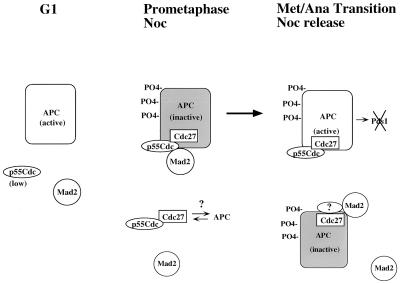Figure 5.
Model for the regulation of the APC by Mad2. In G1 cells, the APC is capable of degrading Pds1 and cyclin B independent of an associated p55Cdc. No Mad2/p55Cdc or APC/p55Cdc complexes are detected in this phase of the cell cycle. In prometaphase and/or after checkpoint activation with the mitotic spindle inhibitor nocodazole (NOC), Mad2 and p55Cdc are complexed with the APC that is inactivated by virtue of the presence of Mad2. Free p55Cdc/Cdc27 complexes may exist in this phase of the cell cycle but, we speculate, are not part of the APC. At the metaphase-to-anaphase transition (or after nocodazole release), the Mad2/p55Cdc interaction is lost before the loss of the p55Cdc/APC interaction, allowing the latter complex to ubiquitinate the anaphase inhibitor Pds1. Mad2/Cdc27/APC complexes may exist at this time but are lost before the degradation of cyclin B (see text for details).

